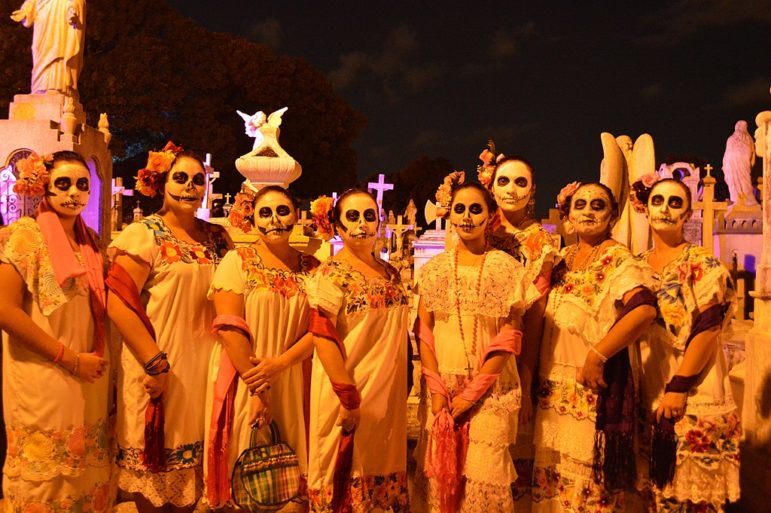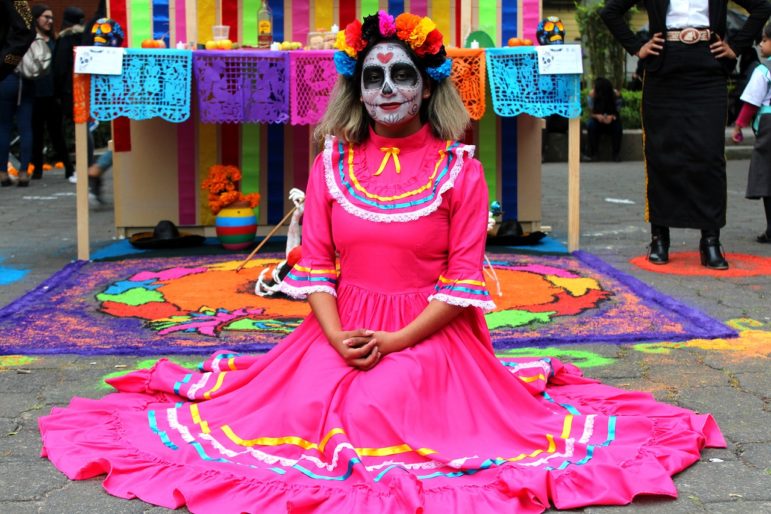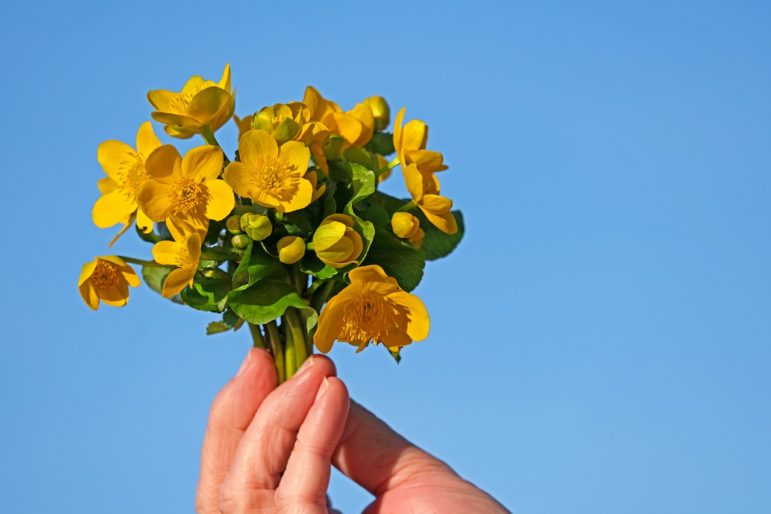
When September arrives, a series of deep questions and reflective thoughts start running in my mind. The year is about to end. Where did it go? How did it happen so fast? What have I done this year? What did I accomplish? And while I interrogate myself, the days of September quickly pass by, nature starts to decay triggering sweet smells, and the Sun’s light changes manifesting a nostalgic feeling in my heart – until I realize Autumn has officially started.
Autumn is my favorite part of the year because my beloved celebrations happen during this time: Samhain, which I celebrate as part of my Wiccan life; and the Day of the Dead, which I have celebrated since I was a child. Both constitute for me the climax of the harvest season.

A Day of the Dead celebration in a cemetery in Yucatan, Mexico [public domain, Wikimedia Commons, CC 1.0]
The first part of my harvest season spiritual celebrations entail questioning myself what am I harvesting this year and what am I grateful for, which usually takes me to think of the people I loved who have passed away and how I would like to share my accomplishments and wins with them. I think of my grandfather and how I would love to celebrate my recent promotion with him. I also think of how I am still able to enjoy today the blessings they gave me when they were alive. I think of my grandmothers and their unconditional love, and how their love and care are a huge component of the type of person I am.
The second part of my harvest celebrations consists in reflecting how others, helped or influenced my harvest manifesting, either directly or indirectly, either alive or in spirit. I think of those who supported me, who were patient with me, who taught me, who guided me, and I send my intention for those blessings to be manifested and multiplied on their end. And I think of those who, although are not alive, their lives’ legacy contributed to my life today.
The third and last part of my harvest celebrations is where I reflect on my harvest and what I am I going to do with it. As my ancestors blessed my harvest, how can my harvest bless others? How can my harvest bless the generations to come? I ponder on what I am going to sow next year, the blessings I am going to pray for, and how the harvests to come are going to contribute to others’ sowing. I think of how I am blessed by my ancestors, but how that also means I am a future ancestor of generations to come.

A woman in a pink dress, wearing Day of the Dead makeup, kneels in front of a street altar [Eduardo Taboada, Pixabay]
Usually, when the Day of the Dead is mentioned, what comes to mind are sugar skulls, marigolds, altars; the colorful and bright part of the celebration. However, below the surface, celebrating our harvest and sharing it with our ancestors, and expressing our gratitude with them is the core and basis of the spiritual side of the Day of the Dead celebration.
The Day of the Dead is, first and foremost, a diverse celebration. It is celebrated differently in each region in Mexico, Latin America, and across the borders. Some people celebrate it for a day or a few, on November 1st or 2nd, while others celebrate for weeks. More than 40 Indigenous groups in Mexico hold rituals associated with the Day of the dead, and these influence the non-Indigenous peoples that live in or around these areas. The most common activity is setting up the Day of the Day altar, but others visit their loved ones’ graves. Others sing, others dance, others perform, others even exhume the remains of their loved ones to clean the bones, like the Mayan community of Pomuch in the state of Campeche. Nonetheless, the common and most important element is that the Day of the Dead consists in honoring our loved ones who have passed away.
The origin of the celebration is full of syncretism. The way our Mesoamerican ancestors related to death and the Catholic calendar and beliefs brought by (or rather imposed by) the Spanish Conquest shaped the celebration. Nonetheless, the Day of the Dead celebration is a living tradition that continues to evolve while it mingles with other cultures and festivities. Some homes in Mexico may have Day of the Dead symbols mixed with Halloween decorations. Some Pagans and Witches in Mexico incorporate Day of the dead symbols to their Samhain celebrations and include Cempasúchil (marigold) flowers and sugar skulls along with jack-o-lanterns in their Samhain rituals. Although the Day of the Dead has Catholic origins, it is celebrated by infinite types of people, no matter the religion.

A hand holding a bunch of marigolds [NickyPe, Pixabay]
What many people don’t know, without regard if they are of Latinx origin or not, is that the Day of the Dead is a harvest celebration, a transition from a period of scarcity to a time of abundance. The basis of the Day of the Dead celebrations are rooted in the customs of the indigenous people of the central and south regions of Mexico and are related to the agricultural cycle of the maize.
The Day of the Dead marks the end of the rainy season and the time of the harvest of the maize. During this celebration, we share the blessings of our harvest with our ancestors and we also express our gratitude to them, as the harvest would not have been possible without their blessing. Its counterpart, the Catholic fiesta of la Santa Cruz (Festival of the Crosses), celebrated on May 3rd, marks the beginning of the rainy season and the start of the sowing of the maize. Prayers are given to the ancestors (and to the divine) asking for their blessing, to ensure fertility and for the crops to grow.
Just as death is not an end but a part of a cycle, the Day of the Dead is also part of a cycle. The Day of the Dead is usually seen as just a time when our dead loved ones return and visit us. My personal point of view of the Day of the Dead is that it is not that they are coming back or visiting us. Instead, while the veil between the worlds is thinner, at this time of the year, it is when we notice they are here. They have always been here. They never left. While the veil is becoming thinner it is like mists between us and our loved ones were dissolving. And when we notice them, we are so happy to be able to share our blessing with them once again.
Editor’s note: For more of Jaime’s thoughts on the Day of the Dead, including its history, origins, and diversity of celebrations, check out his new book, Llewellyn’s Little Book of the Day of the Dead. He explains different ways of celebrating, including activities, recipes, rituals, meditations, and how to set up a Day of the Dead altar.
THE WILD HUNT ALWAYS WELCOMES GUEST SUBMISSIONS. PLEASE SEND PITCHES TO ERIC@WILDHUNT.ORG.
THE VIEWS AND OPINIONS EXPRESSED BY OUR DIVERSE PANEL OF COLUMNISTS AND GUEST WRITERS REPRESENT THE MANY DIVERGING PERSPECTIVES HELD WITHIN THE GLOBAL PAGAN, HEATHEN, AND POLYTHEIST COMMUNITIES, BUT DO NOT NECESSARILY REFLECT THE VIEWS OF THE WILD HUNT INC. OR ITS MANAGEMENT.
The Wild Hunt is not responsible for links to external content.
To join a conversation on this post:
Visit our The Wild Hunt subreddit! Point your favorite browser to https://www.reddit.com/r/The_Wild_Hunt_News/, then click “JOIN”. Make sure to click the bell, too, to be notified of new articles posted to our subreddit.